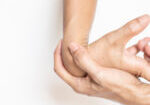EDS 101: Understanding Hypermobility in the Hand Therapy Setting
Classé sous Diagnostics
EDS in the Hand Therapy Setting

General Overview:
Ehlers Danlos Syndrome (EDS) is a group of heritable connective tissue disorders caused by
genetic changes that affect collagen production, the protein responsible for strength and elasticity
in skin, ligaments and tendons (The Ehlers Danlos Society, 2016).
There are thirteen forms of EDS that each have their own set of features with distinct diagnostic
criteria. Of the thirteen the most common subtype of EDS is hypermobile Ehlers-Danlos
Syndrome (hEDS) which can include symptoms such as chronic muscle and douleur articulaire,
subluxations/dislocations, joint pain, muscle pain, etc.

Many individuals also experience coexisting conditions that need to be considered during
evaluation and treatment planning, as these can significantly affect activity tolerance and
participation.
Common comorbidities include:
- Postural Orthostatic Tachycardia Syndrome (POTS) – A Condition that causes an
individual’s heart to beat faster than normal when transitioning from sitting or lying down
to standing up. POTS is a type of orthostatic intolerance that limits the body’s ability to
balance blood vessel constriction and heart rate response. (Clevland Clinic, 2022) - Fibromyalgia: A chronic health condition which causes pain and tenderness throughout
the body, often causing musculoskeletal pain and fatigue. (Clevland Clinic, 2022)
Treatment Goals and Focus:
The primary goals of therapy are to improve joint stability, strengthen and support function, not
to “fix” hypermobility, but to improve control and confidence in movement. - Exercice thérapeutique: Brittian et al. (2024) reported that muscle strengthening and joint
position exercises to neutral and hyperextended ranges help to improve strength pain and
quality of life. - Attelle: Assists with stabilizing joints, reducing pain, and dislocation. Splints for EDS
can include plastic ring splints (oval 8 splints), silver ring splints, wrist supports and
stainless-steel ring splints. Jensen et al. (2020) found that finger orthoses may have a
positive effect on hand function for individuals with EDS. - Pain management strategies: Physical modalities, dry needling, and complementary
therapies may be incorporated to address chronic pain. - Patient education: Instruction on joint protection strategies, ergonomic modification and
energy conservation is essential. Brittian et al. (2024) explain there was an improved understanding of necessary lifestyle modification when there was a multimodal approach such as education on diagnosis and activity modification.
Why it Matters for Therapists:
Understanding EDS is crucial for clinicians because these clients often present with non-specific
pain and instability that may not fit the classic injury or overuse patterns that are taught. Early
recognition of hypermobility and connective tissue symptoms can help prevent unnecessary
interventions. Hakim (2018) emphasizes how occupational therapists can assist with assistive
devices, pain management tailored to symptoms, joint stability, and splints to improve alignment
and control.
Evidence shows that strengthening, joint protection, splinting, and patient education can
significantly improve function and quality of life for those with EDS. As a provider, it is
important that how we deliver care is just as important as what we deliver. By understanding the
patient’s unique presentation and tailoring interventions accordingly, therapists can help
individuals with EDS move and feel better.
Les références
Brittain, M., Flanagan, S., Foreman, L., & Teran-Yengle, P. (2023). Physical therapy
interventions in generalized hypermobility spectrum disorder and hypermobile Ehlers-
Danlos syndrome: a scoping review. Disability and Rehabilitation, 46(10), 1–18.
https://doi.org/10.1080/09638288.2023.2216028
Cleveland Clinic. (2022). Fibromyalgia. Cleveland Clinic.
https://my.clevelandclinic.org/health/diseases/4832-fibromyalgia
Cleveland Clinic. (2022). Postural orthostatic tachycardia syndrome (POTS). Cleveland Clinic.
https://my.clevelandclinic.org/health/diseases/16560-postural-orthostatic-tachycardia-
syndrome-pots
Colin M.E. Halverson, Cao, S., Perkins, S. M., & Francomano, C. A. (2023). Comorbidity,
misdiagnoses, and the diagnostic odyssey in patients with hypermobile Ehlers-Danlos
Syndrome. Genetics in Medicine Open, 1(1), 100812–100812.
https://doi.org/10.1016/j.gimo.2023.100812
Hakim, A. (2018). Hypermobile Ehlers-Danlos Syndrome. Nih.gov; University of Washington,
Seattle. https://www.ncbi.nlm.nih.gov/books/NBK1279/
Jensen, A.-M., Andersen, J. Q., Quisth, L., & Ramstrand, N. (2020). Finger orthoses for
management of joint hypermobility disorders: Relative effects on hand function and
cognitive load. Prosthetics and Orthotics International, 030936462095686.
https://doi.org/10.1177/0309364620956866
Mast cell activation disorder Archives – The Ehlers-Danlos Support UK. (2024). The Ehlers-
Danlos Support UK. https://www.ehlers-danlos.org/what-is-eds/information-on-eds/mast-
cell-activation-disorder/
The Ehlers Danlos Society. (2016). The Ehlers-Danlos Society. The Ehlers Danlos Society.
https://www.ehlers-danlos.com/
Plus à lire
Douleur à la main pendant la grossesse et le nouveau parent
Par : Rachel Reed La transition vers la parentalité peut être difficile pour le corps d'une mère ou d'un parent, surtout si l'on considère l'augmentation de l'utilisation répétitive des mains nécessaire pour prendre soin d'un bébé. Les affections des membres supérieurs les plus courantes qui se développent pendant la grossesse et après l'accouchement sont le syndrome du canal carpien et la ténosynovite de Quervain (Wagner, 2019). Souvent, du nouveau…
En savoir plusÉtirement après un AVC pour la spasticité
Examen rapide par : Mikayla Murphy Kerr, L., Jewell, VD et Jensen, L. (2020). Interventions d'étirement et d'attelle pour la spasticité post-AVC, la fonction de la main et les tâches fonctionnelles : une revue systématique. American Journal of Occupational Therapy, 74, 7405205050. https://doi.org/10.5014/ajot.2020.029454 The Skinny Cette étude s'est concentrée sur les avantages de l'étirement du membre supérieur pour diminuer la spasticité, augmenter…
En savoir plusTraitement du canal carpien : attelle uniquement ou attelle et traitement conservateur
Résultat clinique à court terme de l'orthèse seule par rapport à la combinaison d'orthèses, d'exercices de glissement des nerfs et des tendons et d'une thérapie par ultrasons pour le traitement du syndrome du canal carpien. Sim, Sze En et al. Journal of Hand Therapy, Volume 32, Numéro 4, 411 – 416 Le syndrome du canal maigre-carpien (CTS) est la neuropathie de compression la plus courante. Compression du…
En savoir plusTitre : Comprendre la pathologie de De Quervain : une exploration complète des tests spéciaux
Comprendre la pathologie de De Quervain : une exploration complète des tests spéciaux Par : Miranda Materi La ténosynovite de De Quervain est une affection caractérisée par une inflammation des tendons du côté du pouce du poignet, provoquant des douleurs et un inconfort. Ces tendons comprennent l'abducteur du pouce long (APL) et l'extenseur du pouce court lorsqu'ils traversent…
En savoir plusInscrivez-vous pour recevoir des mises à jour directement dans votre boîte de réception !
Inscrivez-vous avec nous et nous vous enverrons régulièrement des articles de blog sur tout ce qui concerne la thérapie des mains, des notifications chaque fois que nous mettons en ligne de nouvelles vidéos et tutoriels, ainsi que des documents, des protocoles et d'autres informations utiles.






